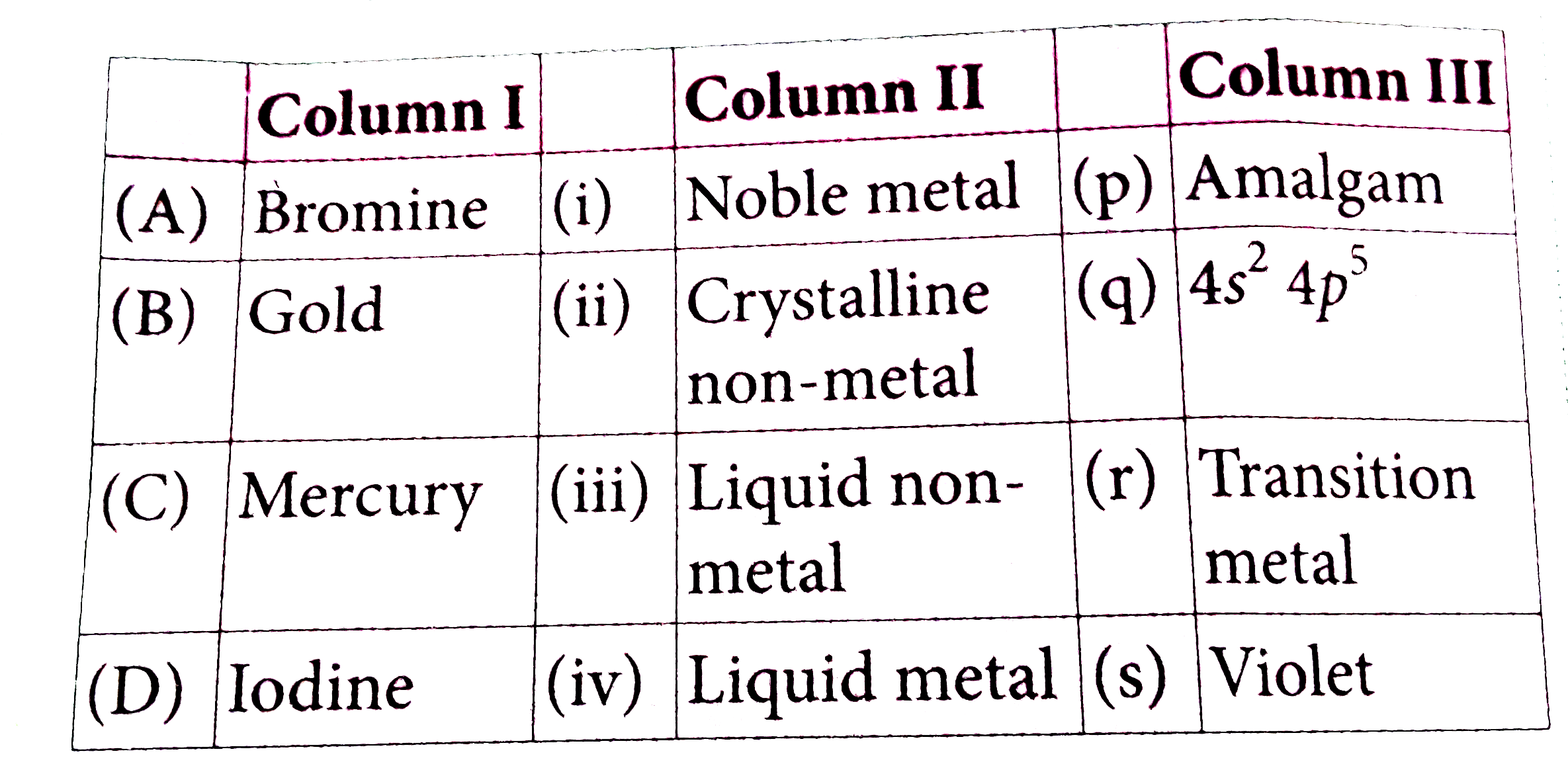Match the column I with column II and mark the appropriate choice.
(A) (ii), (B) (iv), (C ) (i), (D) (iii)
(A) (i), (B) (ii), (C ) (iii), (D) (iv)
(A) (ii), (B) (iii), (C ) (i), (D) (vi)
(A) (iii), (B) (i), (C ) (ii), (D) (iv)
The correct Answer is:A
To solve the problem of matching Column I with Column II, we will analyze each item in Column I and find its corresponding chemical formula in Column II.
1. Identify Borax:
- Borax is commonly known as Sodium Tetraborate Decahydrate.
- The chemical formula for Borax is Na2B4O7⋅10H2O.
- Therefore, Borax (A) matches with (ii) Na2B4O7⋅10H2O.
2. Identify Inorganic Benzene:
- Inorganic benzene refers to Borazine.
- The chemical formula for Borazine is B3N3H6.
- Thus, Inorganic Benzene (B) matches with (iv) B3N3H6.
3. Identify Cryolite:
- Cryolite is used in the extraction of aluminum and has the formula Na3AlF6.
- Therefore, Cryolite (C) matches with (i) Na3AlF6.
4. Identify Bauxite:
- Bauxite is an ore of aluminum and its formula is Al2O3⋅2H2O.
- Hence, Bauxite (D) matches with (iii) Al2O3⋅2H2O.
Final Matching:
- (A) Borax → (ii) Na2B4O7⋅10H2O
- (B) Inorganic Benzene → (iv) B3N3H6
- (C) Cryolite → (i) Na3AlF6
- (D) Bauxite → (iii) Al2O3⋅2H2O
Conclusion:
The correct option is (A) → (ii), (B) → (iv), (C) → (i), (D) → (iii).
- Borax is commonly known as Sodium Tetraborate Decahydrate.
- The chemical formula for Borax is Na2B4O7⋅10H2O.
- Therefore, Borax (A) matches with (ii) Na2B4O7⋅10H2O.
- Inorganic benzene refers to Borazine.
- The chemical formula for Borazine is B3N3H6.
- Thus, Inorganic Benzene (B) matches with (iv) B3N3H6.
- Cryolite is used in the extraction of aluminum and has the formula Na3AlF6.
- Therefore, Cryolite (C) matches with (i) Na3AlF6.
- Bauxite is an ore of aluminum and its formula is Al2O3⋅2H2O.
- Hence, Bauxite (D) matches with (iii) Al2O3⋅2H2O.
- (A) Borax → (ii) Na2B4O7⋅10H2O
- (B) Inorganic Benzene → (iv) B3N3H6
- (C) Cryolite → (i) Na3AlF6
- (D) Bauxite → (iii) Al2O3⋅2H2O
The correct option is (A) → (ii), (B) → (iv), (C) → (i), (D) → (iii).
Topper's Solved these Questions
- BOOK - NCERT FINGERTPS ENGLISHCHAPTER - THE P-BLOCK ELEMENTSEXERCISE - HIGHER ORDER THINKING SKILLS9videos
THE P-BLOCK ELEMENTS
- BOOK - NCERT FINGERTPS ENGLISHCHAPTER - THE P-BLOCK ELEMENTSEXERCISE - EXEMPLAR PROBLEMS15videos
THE P-BLOCK ELEMENTS
- BOOK - NCERT FINGERTPS ENGLISHCHAPTER - STRUCTURE OF ATOM EXERCISE - Assertion And Reason15videos
STRUCTURE OF ATOM
- BOOK - NCERT FINGERTPS ENGLISHCHAPTER - THE S-BLOCK ELEMENTSEXERCISE - Assertion And Reason15videos
THE S-BLOCK ELEMENTS
Similar Questions
Knowledge Check
- Question 1 - Select One
Match the column I with column II and mark the appropriate choice
Column IColumn II(A)Borax-bead(i)Alum(B)Inorganic benzene(ii)Diborane(C)Antiseptic(iii)Metaborate(D)Bridged hydrogens(iv)BorazineA(A) → (i), (B) → (iii), (C ) → (ii), (D) → (iv)B(A) → (iii), (B) → (iv), (C ) → (i), (D) → (ii)C(A) → (iv), (B) → (iii), (C ) → (i), (D) → (ii)D(A) → (ii), (B) → (iii), (C ) → (vi), (D) → (i) - Question 2 - Select One
Match the Column I with column II and mark the appropriate choice.
Column IColumn II(A)Coal gas(i)CO+H2(B)Synthesis gas(ii)CH4(C)Producer gas(iii)H2+CH4+CO(D)Natural gas(iv)CO+N2A(A) → (i), (B) → (ii), (C ) → (iii), (D) → (iv)B(A) → (iii), (B) → (i), (C ) → (iv), (D) → (ii)C(A) → (iv), (B) → (iii), (C ) → (ii), (D) → (i)D(A) → (i), (B) → (iii), (C ) → (i), (D) → (iv) - Question 3 - Select One
Match the column I with column II and mark the appropriate choice.
Column IColumn II(A)Fe(OH)3(i)Ksp=s2(B)Ag2CrO4(ii)Ksp=27s4(C)CH3COOAg(iii)Ksp=108s5(D)Ca3(PO4)(iv)Ksp=4s3A(A)→(iii),(B)→(ii),(C)→(iv),(D)→(i)B(A)→(ii),(B)→(iv),(C)→(i),(D)→(iii)C(A)→(i),(B)→(iii),(C)→(ii),(D)→(iv)D(A)→(iv),(B)→(i),(C)→(iii),(D)→(ii)
Match the column I with column II and mark the appropriate choice.
Column IColumn II(A)C2H2(i)sp3d2 hybridisation(B)SF6(ii)sp3d3 hybridisation(C)SO2(iii)sp hybridisation(D)IF7(iv)sp2 hybridisationView SolutionMatch the compounds given in column I with oxidation states of carbon given in column II and mark the appropriate choice.
Column IColumn II(A)C6H12O6 (i) +3(B)CHCl3 (ii) -3(C)CH3CH3 (iii) +2(D)(COOH)2 (iv) 0View SolutionMatch the rate law given in column I with the dimensions of rate constants given in column II and mark the appropriate choice.
Column IColumn II(A)Rate=k[NH3]0(i)molL−1s−1(B)Rate=k[H2O2][I−](ii)Lmol−1s−1(C)Rate=k[CH3CHO]3/2(iii)S−1(D)Rate=k[C5H5CI](iv)L1/2mol−1/2s−1View SolutionMatch the colomn I with column II and mark the appropriate choice.
Column IColumn II(A)Used as lubricant(i)Carbon dioxide(B)Oxide with three dimensional structure(ii)Grapite(C)Used in solar cells(iii)Siica(D)Anhydride of carbonic acid(iv)SiliconView SolutionMatch the bond enthalpies given in column II with the molecules given in column I and mark the appropriate choice.
Column IColumn II (A)Hydrogen (H2)(i)498.0 kJ mol−1(B)Oxygen(O2)(ii)946.0 kJ mol−1(C)Nitrogen(N2)(iii)435.8 kJ mol−1View Solution


